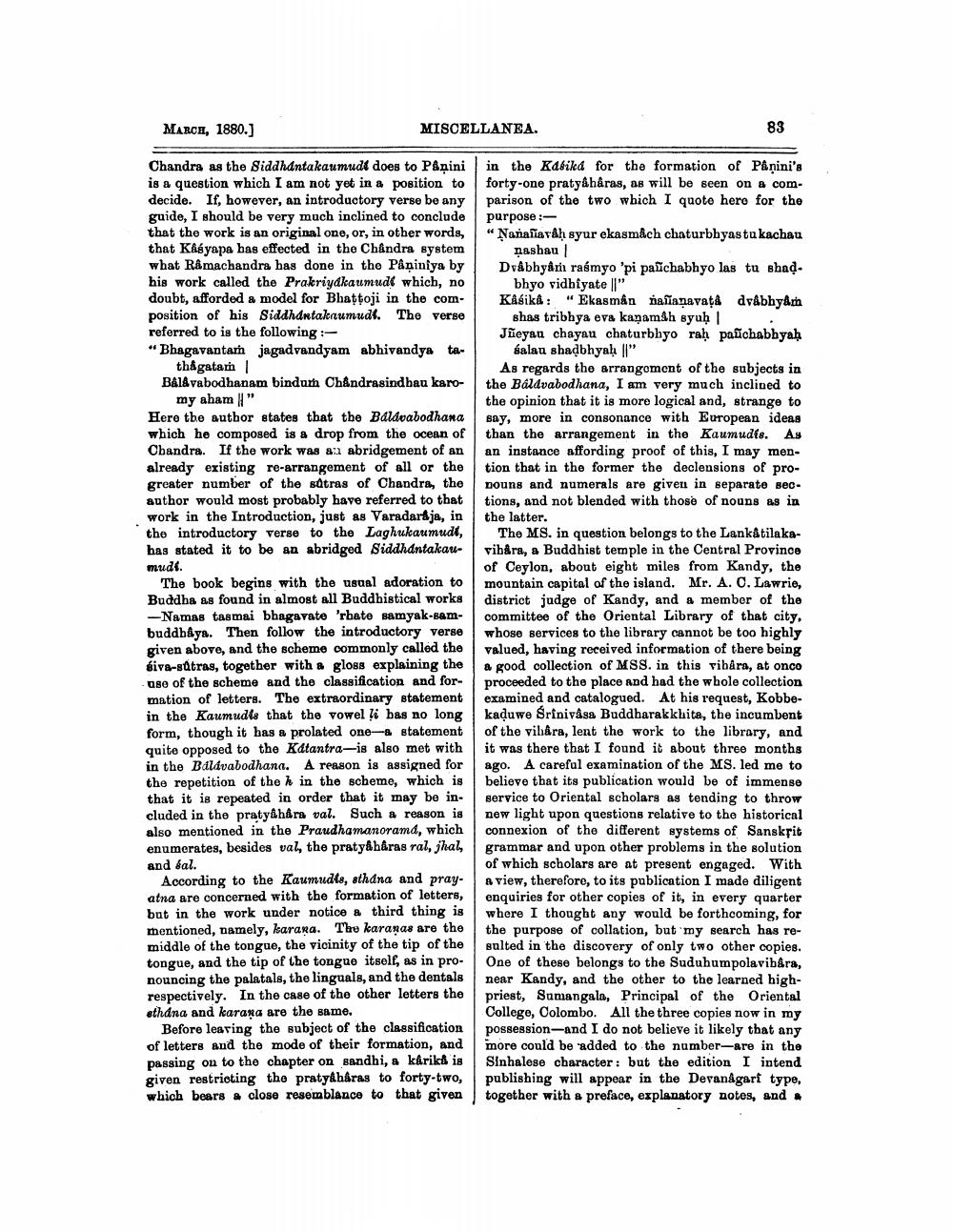________________
MARCH, 1880.]
Chandra as the Siddhántakaumudi does to Pânini is a question which I am not yet in a position to decide. If, however, an introductory verse be any guide, I should be very much inclined to conclude that the work is an original one, or, in other words, that Kasyapa has effected in the Chandra system what Ramachandra has done in the Pâniniya by his work called the Prakriydkaumud which, no doubt, afforded a model for Bhaṭṭoji in the composition of his Siddhantakaumudt. The verse referred to is the following:"Bhagavantaṁ jagadvandyam abhivandya tathagatam |
Bâlâvabodhanam bindum Chandrasindhau karomy aham ||"
Here the author states that the Bálavabodhana which he composed is a drop from the ocean of Chandra. If the work was an abridgement of an already existing re-arrangement of all or the greater number of the sutras of Chandra, the author would most probably have referred to that work in the Introduction, just as Varadaraja, in the introductory verse to the Laghukaumudi, has stated it to be an abridged Siddhantakaumudi.
MISCELLANEA.
The book begins with the usual adoration to Buddha as found in almost all Buddhistical works -Namas tasmai bhagavate 'rhate samyak-sambuddhaya. Then follow the introductory verse given above, and the scheme commonly called the siva-sutras, together with a gloss explaining the -use of the scheme and the classification and formation of letters. The extraordinary statement in the Kaumudis that the vowel li has no long form, though it has a prolated one-a statement quite opposed to the Kátantra-is also met with in the Balavabodhana. A reason is assigned for the repetition of the h in the scheme, which is that it is repeated in order that it may be included in the pratyåhåra val. Such a reason is also mentioned in the Praudhamanorama, which enumerates, besides val, the pratyâhâras ral, jhal, and bal.
According to the Kaumudis, sthana and prayatna are concerned with the formation of letters, but in the work under notice a third thing is mentioned, namely, karana. The karanas are the middle of the tongue, the vicinity of the tip of the tongue, and the tip of the tongue itself, as in pronouncing the palatals, the linguals, and the dentals respectively. In the case of the other letters the ethana and karana are the same.
Before leaving the subject of the classification of letters and the mode of their formation, and passing on to the chapter on sandhi, a kârika is given restricting the pratyahâras to forty-two, which bears a close resemblance to that given
83
in the Kábika for the formation of Pânini's forty-one pratyâhâras, as will be seen on a comparison of the two which I quote here for the purpose:
"Nañañavaḥ syur ekasmâch chaturbhyastu kachau nashau
Dvabhyam raśmyo 'pi pañchabhyo las tu shaḍbhyo vidhiyate ||"
Kasika: "Ekasman nallanavatâ dvâbhyâm shas tribhya eva kaṇamâh syuḥ | Jieyau chayau chaturbhyo rah pañchabhyaḥ salau shadbhyah ||"
As regards the arrangement of the subjects in the Bálavabodhana, I am very much inclined to the opinion that it is more logical and, strange to say, more in consonance with European ideas than the arrangement in the Kaumudis. As an instance affording proof of this, I may mention that in the former the declensions of pronouns and numerals are given in separate sections, and not blended with those of nouns as in the latter.
The MS. in question belongs to the Lankatilakavihara, a Buddhist temple in the Central Province of Ceylon, about eight miles from Kandy, the mountain capital of the island. Mr. A. C. Lawrie, district judge of Kandy, and a member of the committee of the Oriental Library of that city, whose services to the library cannot be too highly valued, having received information of there being a good collection of MSS. in this vihara, at onco proceeded to the place and had the whole collection examined and catalogued. At his request, Kobbekaduwe Srinivasa Buddharakkhita, the incumbent of the vihara, lent the work to the library, and it was there that I found it about three months ago. A careful examination of the MS. led me to believe that its publication would be of immense service to Oriental scholars as tending to throw new light upon questions relative to the historical connexion of the different systems of Sanskrit grammar and upon other problems in the solution of which scholars are at present engaged. With a view, therefore, to its publication I made diligent enquiries for other copies of it, in every quarter where I thought any would be forthcoming, for the purpose of collation, but my search has resulted in the discovery of only two other copies. One of these belongs to the Suduhumpolavibâra, near Kandy, and the other to the learned highpriest, Sumangala, Principal of the Oriental College, Colombo. All the three copies now in my possession and I do not believe it likely that any more could be added to the number-are in the Sinhalese character: but the edition I intend publishing will appear in the Devanagari type, together with a preface, explanatory notes, and a




